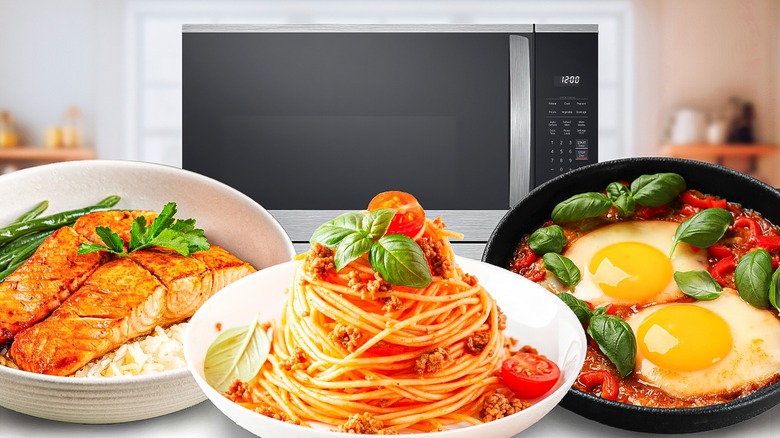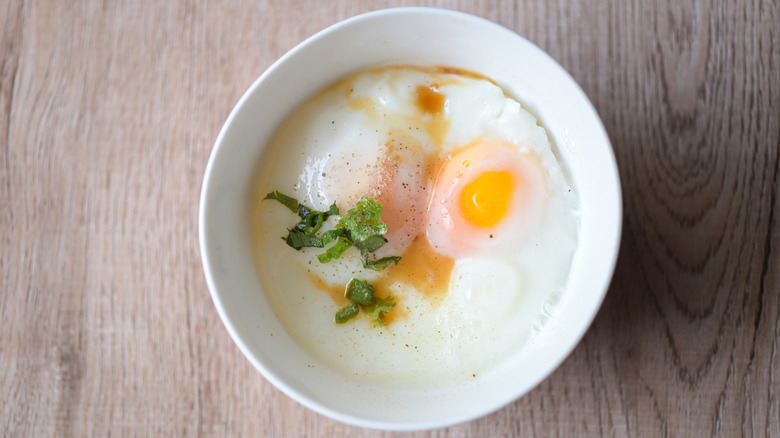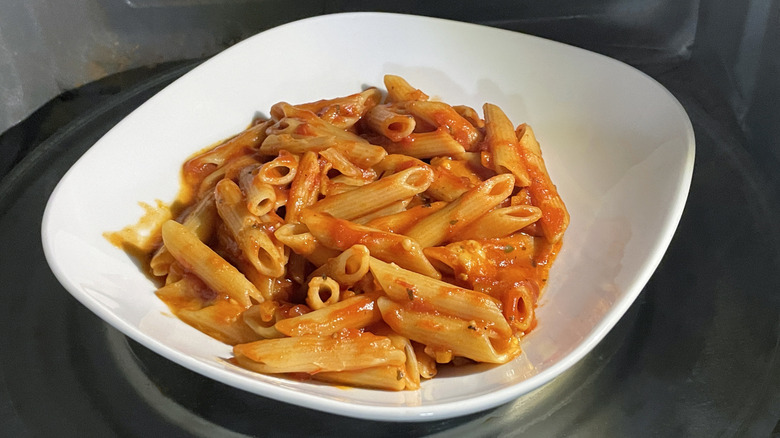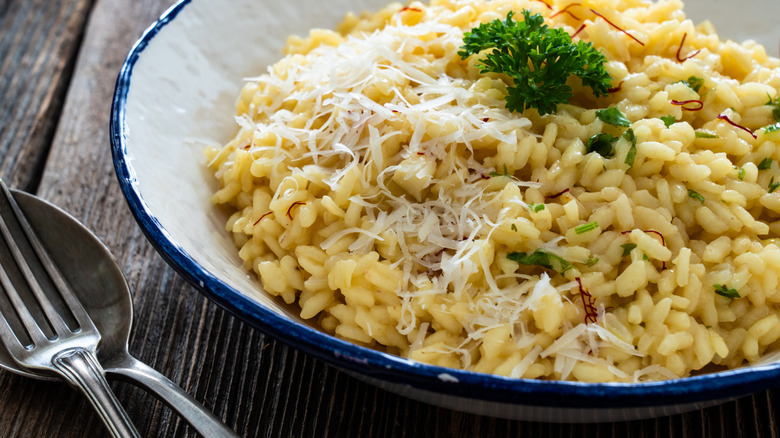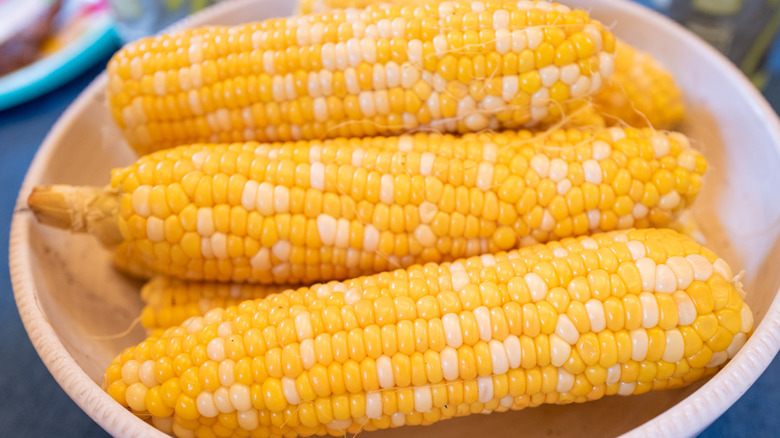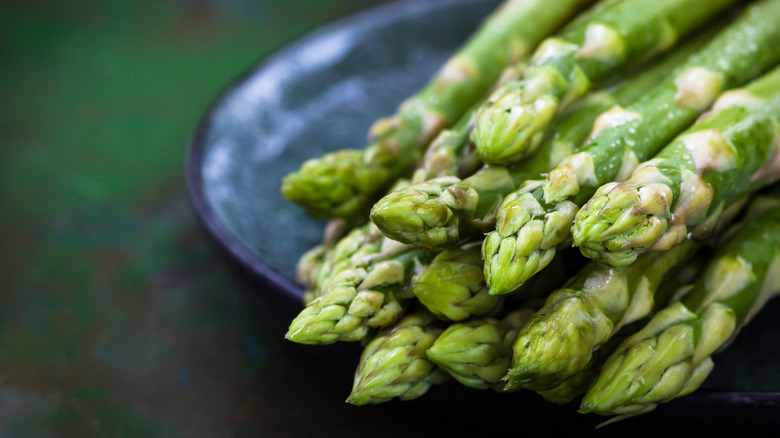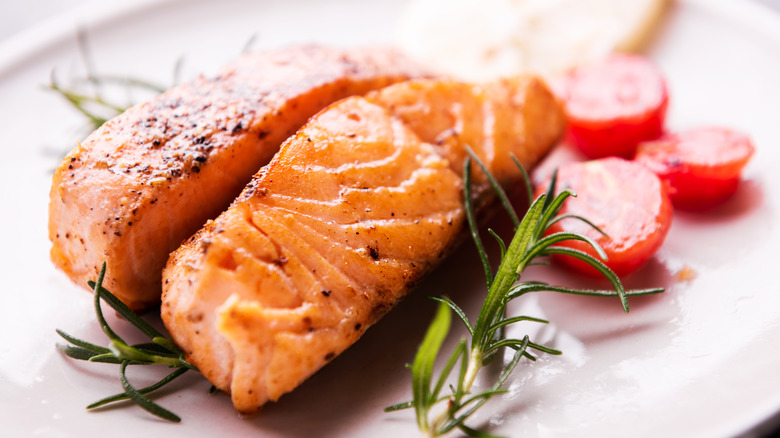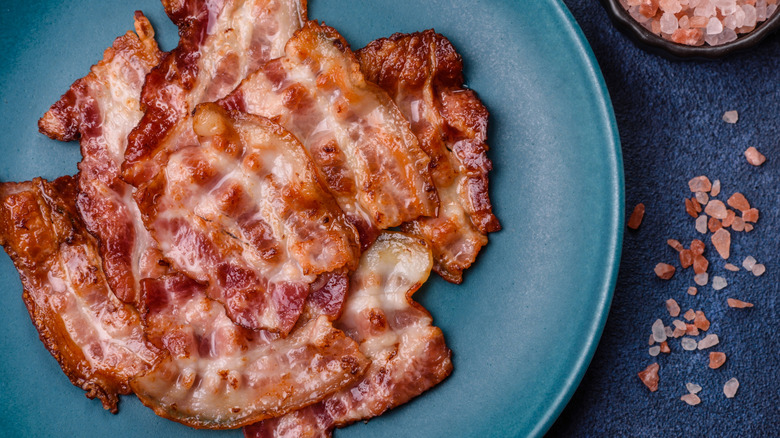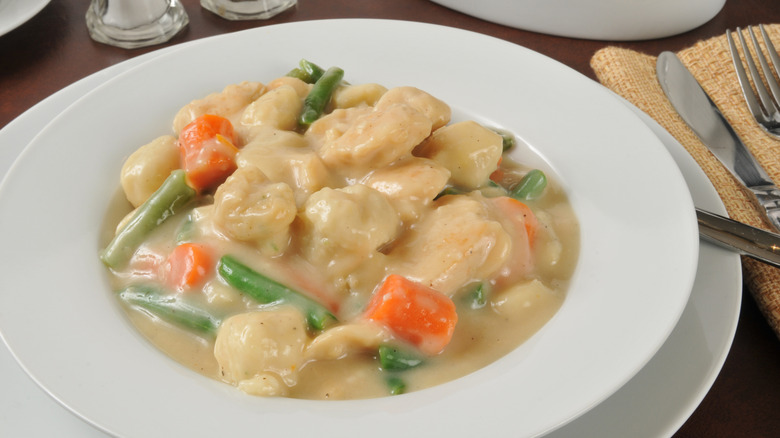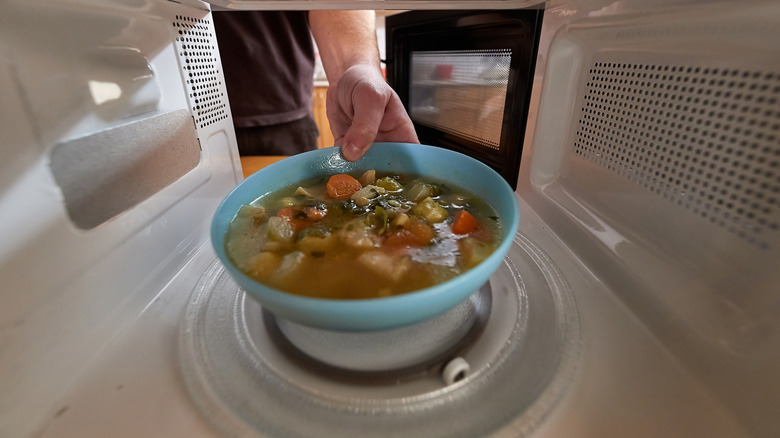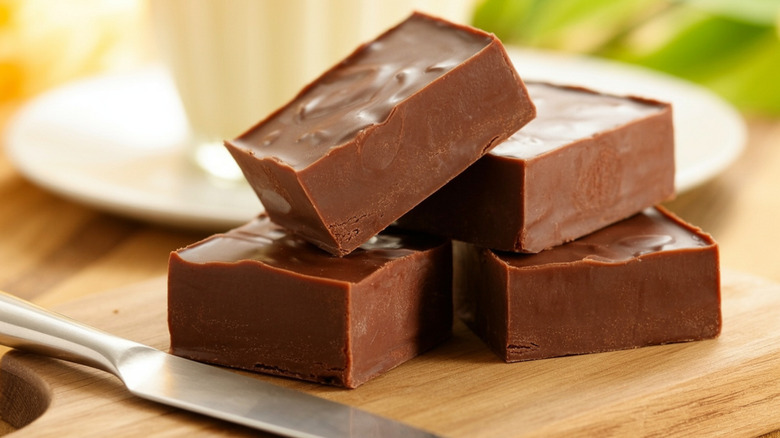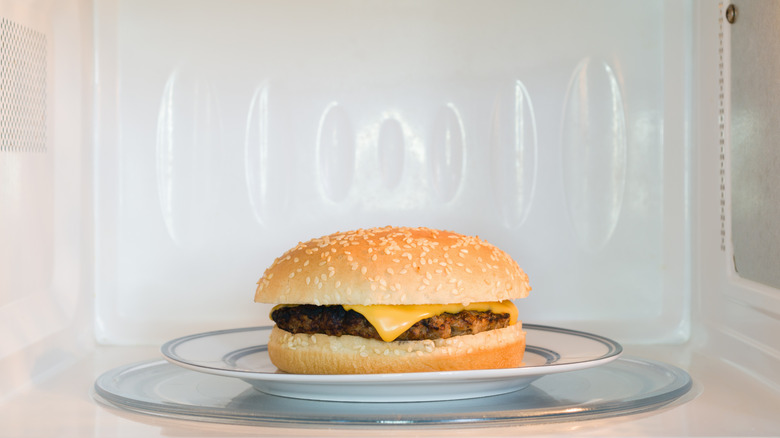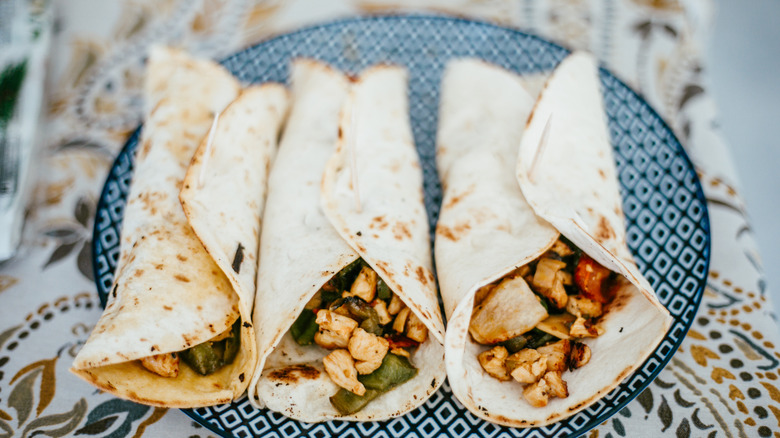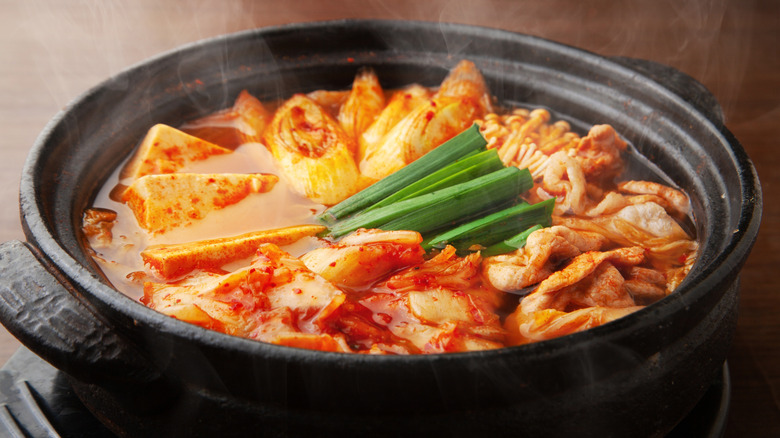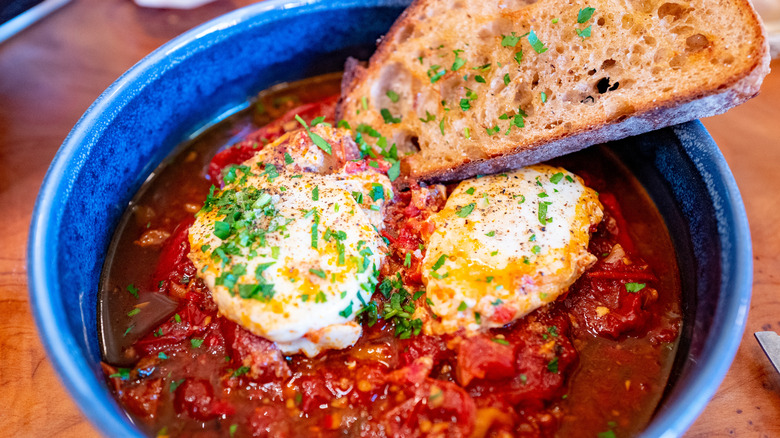14 Foods You Can Ditch The Stove For And Quickly Cook In The Microwave Instead
Maybe you just don't feel like pulling out a bunch of pots and pans, turning on the burners, and babysitting the stove. Maybe it's too hot outside to even fathom adding another heat source to your house. Maybe you want something quick and easy. Maybe you don't have access to a stove at all. Whatever the case may be, the magical microwave is the solution.
Sure, some may malign the microwave as a source of overly processed junk food, enabling your habitual hankerings for frozen heat-and-eat meals or microwave popcorn, but this kitchen appliance doesn't get half the recognition it deserves. What else can cook a full meal in minutes through the mystical process of using high-frequency electric fields to vibrate the water molecules in your food, to the point that they emit heat, thereby cooking whatever ingredient you've thrown inside? Truly, we may be taking the microwave for granted — but, if you want to get the full value from your microwave, there's plenty you can cook using just the appliance and some microwave-safe dishes.
Eggs
Okay, you've probably had a bad microwaved egg at some point in your life. Putting an egg in the microwave is risky business. You could end up with an egg-splosion (sorry-not-sorry) if you try to hard-boil an egg in the microwave, or you could end up with egg-ceptionally (again, sorry-not-sorry) dry "scrambled" egg. However, if you fine-tune your process, you could just find that cooking eggs in the microwave results in the easiest omelet you'll ever make.
The secret lies in adding enough fat and liquid to your microwaved eggs. You'll want to apply non-stick cooking spray to your vessel of choice, or butter it up. Then, you'll also want to add water or milk to the eggs themselves (alongside your standard omelet fixin's). From there, all it takes is a minute to a minute-and-a-half in the microwave, with breaks every 20 to 30 seconds for stirring.
Don't fancy an omelet? Poached eggs are pretty easy in the microwave, too. Just crack your egg into a small bowl, completely cover it with water (and a splash of vinegar), and microwave it in 30-second increments, until it's done to your liking.
Pasta
Boiling pasta certainly isn't a giant imposition and it's something that really anyone could do — but if you're trying to cut down on the amount of time you need to spend overseeing the stovetop, or the amount of heat and steam entering your kitchen, you'll want to swap cooking your pasta in a pot of boiling water for cooking it in the microwave instead.
Cooking pasta in the microwave is incredibly simple. Just cover the pasta in water, in a microwave-safe bowl, and cook the pasta as long as the box instructs you to, but add three minutes. Then, drain the pasta and top it with whatever sauce you like.
Some forms of pasta work better in the microwave than others. You want the pasta to be totally submerged in the water, so shorter shapes work best, unless you have a particularly long or deep microwavable dish that can accommodate spaghetti and similar pastas.
Risotto
Risotto has a reputation as being one of those fancy dishes that are difficult for home cooks. However, anyone who's really tried their hand at risotto knows that, while it's impressive, it's not that technically difficult to make a good risotto. All it requires is a great degree of patience and time.
However, if you have neither patience nor time, the microwave can help you churn out a good risotto with ease. Do note that you will still need to turn on the stove, but you're not going to need to sit and watch your risotto for half an hour or longer when using the microwave method. To make risotto in the microwave, heat your broth and the rice in olive oil on the stove like you might normally, but then transfer the rice to a microwave-safe dish, covering it with the hot broth. Cover the dish with a microwave-safe lid and microwave the rice for five minutes. Add your wine. Microwave the rice for another 10 minutes. Keep microwaving until the risotto is fully done, adding broth a little at a time, until you've reached that characteristic, risotto creaminess.
Corn on the cob
Microwaving corn on the cob is a fast and efficient way to add an extra side dish to your dinner with absolutely minimal effort. The process is similar to cooking a baked potato in the microwave (a method that, once you try it, you'll use forevermore — no more baking potatoes in the oven for an hour-plus for you). Just wrap the corn cobs in damp paper towels, leaving the ends open to release steam, and then place the corn cobs on a microwavable plate. Toss them into the microwave for three minutes, flip them, and microwave them for three minutes more. You're done.
Even if you don't want to cook your corn on the cob in the microwave — maybe you have other plans, like grilling your corn, so that you get that tasty char — you can still enlist the microwave in helping you complete the dreaded task of husking fresh corn. Rather than getting corn silks beneath your fingernails, you can just heat your corn for a lesser amount of time, in the microwave, so that the husks and silks slide free, but the corn isn't fully cooked through.
Asparagus
Cooking asparagus comes with many potential pitfalls. You could choose the wrong size and type of asparagus. You could store it incorrectly. You could trim it the wrong way. And when it comes to cooking, you could overlook the role your microwave could play in the process. Sure, there's argument over the best method for cooking asparagus, but if you're looking for simple, steamed asparagus, and for tender stalks every time, the microwave should be your go-to.
To microwave your asparagus to perfection, first trim the asparagus as normal, wrap the stalks in a moist paper towel, and then place the asparagus on a microwavable plate. Microwave the asparagus for at least three minutes before checking for doneness. If the asparagus isn't quite done to your liking just yet, continue microwaving in one-minute increments. Do note that, the thicker your asparagus, the longer it'll take to cook, and that thicker stalks may not cook as evenly.
Salmon
We're not going to tell you that you should microwave fish at the office, but if you're hanging out at home and have no pesky roommates to complain about the fishy odor, then go right ahead and microwave yourself a full salmon dinner. Yes, you can cook salmon in the microwave.
After adjusting your microwave so that it's at the medium power setting, wrap your fresh salmon, appropriately oiled up, in damp paper towels. Then, place the salmon on a microwave-safe plate and cook it in the microwave for about three minutes. The paper towels keep the salmon from overcooking, nicely steaming it, so definitely don't skip that step. Once your salmon is done, squeeze a bit of lemon over it and you're good to go. You can add whatever seasoning you like from here.
The result is easy steamed salmon with very little effort, few dishes to clean up, and no question about whether or not the salmon is cooked through. Utilize your microwave to also make some asparagus and risotto, and you have a full dinner.
Bacon
Cooking bacon on the stovetop is both messy and potentially dangerous. Grease flies everywhere. You can, of course, cook your bacon in the oven, which is less messy and safer, but if you don't have time for all that preheating, consider making the microwave your friend.
To cook your bacon in the microwave, grab a couple paper towels and line a microwave-safe plate. You want a doubled-up layer of paper towels to soak up all that bacon grease. Line up your raw bacon strips on the plate. Don't let them touch. Cover the bacon with an equal, doubled-up layer of paper towels, so you don't end up with a disgustingly dirty microwave. Cook the bacon for one minute for every slice you're cooking. Use tongues to transfer the cooked bacon to another, clean paper towel-lined plate and let it cool. While this cooking method may not be ideal if you're trying to cook a big batch of bacon, it's perfect for just cooking a few slices, such as if you're prepping breakfast for one, or if you're making bacon to go into a broader dish.
Chicken and dumplings
Chicken and dumplings, in the microwave? While a Southerner may shudder at the thought, it is possible to make chicken and dumplings in the appliance.
You'll essentially make the chicken and dumplings base in the microwave first. That means cooking your chicken and vegetables in broth, in a microwave-safe casserole dish or bowl. You can condense the amount of time needed for this step by using pre-cooked chicken, like a rotisserie chicken or canned chicken. Then, you'll place your dumpling dough in spoonfuls atop the filling, covering the dish with microwave-safe plastic wrap (with a few holes for steam release) before placing it back in the microwave to continue cooking. The whole process should take less than half an hour. As you go, just make sure you're not making some of the most common mistakes home cooks make with from-scratch chicken and dumplings, such as overworking the dumpling dough or not adding extra spices or seasonings.
Soup
If chicken and dumplings aren't your deal, rest assured that you can make all sorts of soups in the microwave. While, yes, making a stock from scratch and then allowing your homemade soup to simmer on the stove all day has its charm, sometimes you need the comfort that a good soup can bring, stat. You don't have hours to wait.
To make soup in the microwave, grab an extra-deep, big microwavable bowl or similar vessel. Then, add all of your soup ingredients and cook until done. For example, if you wanted to make a microwave chicken noodle soup, you'd add chopped or frozen veg, chicken stock, cooked chicken, and pasta to the bowl, microwaving until the veg and pasta are both done. If you wanted to make broccoli cheddar soup in the microwave, you'd similarly microwave your broccoli in broth until done, and then add your cream or milk and cheese before microwaving again.
Fudge
If you've ever been intimidated by the thought of making homemade fudge around the holidays, you need to try microwave fudge. Melt chocolate chips in the microwave, stirring as you go, and then add in some condensed milk and diced butter. Microwave the mixture until the butter is completely melted and then pour it all into a buttered dish. Chill for a few hours, and you have fudge.
You will want to buy high-quality chocolate chips for this endeavor, for the best fudgy texture. That means avoiding chocolate chips that contain sugar as the primary ingredient. You can also adapt your microwave chocolate fudge recipe further, once you get a hang on the basic recipe. Add in nuts and flavorings. Don't care for chocolate? Make two-ingredient vanilla fudge with just a tub of vanilla frosting and white chocolate confectionery coating chips. Microwave and mix it all together before letting it cool in the fridge.
Burgers
No, we're not talking about nuking a frozen burger patty. If you have fresh beef on your hands, you can make burgers in the microwave in lieu of firing up the grill or heating up your cast iron skillet. Carefully shape the raw ground beef into individual patties, about 4 to 5 inches in diameter. Make a small hole in the middle of each patty, less than an inch in diameter. Season your newly formed beef bagel and plop it onto your trusty microwave-safe plate, covering it with wax paper. Microwave the patty for 40 seconds, flip it over, and microwave it again. Check the internal temperature to ensure the patty is at your preferred level of doneness, then dig in.
Keep in mind that the microwave method is only really ideal for cooking burgers the first time around. When you're reheating burgers, you'll want to avoid the microwave, as it can make the patty rubbery and tough. Instead, reheat burgers using the oven, air fryer, or a covered pan on the stovetop.
Fajitas
When you're craving Mexican, a delicious chicken fajita is only a few minutes of microwaving away. There are two ways you can go about making microwave fajitas.
First, you can opt to cook your chicken from raw. If you go this route, slice your onions and peppers and place them in a microwave-safe dish alongside your chicken breasts. Season as desired. Microwave the dish until the chicken breasts are done cooking and show an internal temperature of 165 degrees Fahrenheit. This should take about 15 minutes. Then, slice the chicken breasts and serve the cooked chicken, peppers, and onions with warmed tortillas.
If you don't want to cook your chicken from raw, and if you're not keen on chopping up your peppers and onion, you can take a more streamlined approach. Combine pre-cooked chicken, such as canned chicken, with seasonings and frozen sliced peppers and onions, in a microwavable bowl. Cover the bowl with a paper towel and microwave it for five minutes, or until the frozen peppers and onions, as well as the chicken, are heated through. Serve on warmed tortillas.
Hot pot
A traditional hot pot experience requires a lot of ingredient prep and then cooking your food at your table, bit by bit. However, if you want hot pot flavors without all the extra effort, microwave hot pot is here for you.
Start by picking your ingredients. Maybe you want rice noodles and mushrooms. Maybe you want thinly sliced steak and bean sprouts. Whatever you choose, you'll cook these ingredients in broth, covered with cabbage leaves. (The cabbage leaves help retain the steam from the cooking process.) After everything is cooked, you can cut your ingredients into bite-size pieces before topping with any other desired ingredients and chowing down. If you don't incorporate rice noodles into your hot pot, consider also microwaving some rice to eat along with it. You can also layer in frozen dumplings. All in all, the cooking process shouldn't take more than 10 minutes. You'll likely spend most of your time simply chopping and dicing your ingredients.
Shakshuka
Once you master the art of poaching eggs in the microwave, level up your game by making shakshuka in the appliance. You only need about five minutes. Just pour marinara or tomato sauce and spices and seasonings into a microwaveable bowl, then crack your eggs directly into the sauce. Carefully poke each egg yolk with a sharp knife, so that the yolk can release steam but it doesn't split and run everywhere. The goal is to keep the egg from exploding in the microwave, while also poaching and remaining perfectly runny. You'll microwave for a single minute first, then cook in 20-second intervals until the egg is cooked to your liking.
If you have a microwaveable pie plate, consider using it to cook your shakshuka rather than a microwaveable bowl. While you won't be able to go straight from microwave to serving (unless you want to eat straight from the pie plate — which we won't judge), the wider cooking surface will allow for even heating of both the tomato sauce and the eggs. It'll also allow for more surface area in which to cook a greater number of eggs, compared to the one or two you could maybe fit into a standard bowl.
